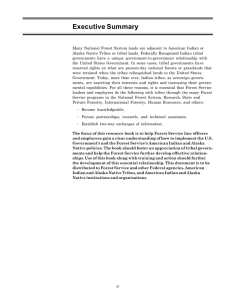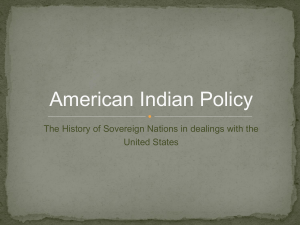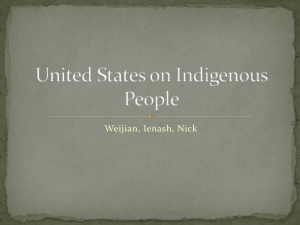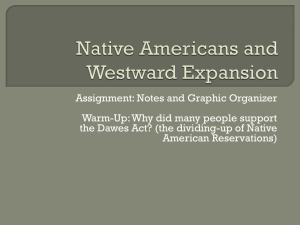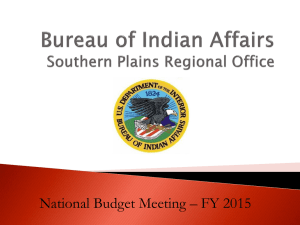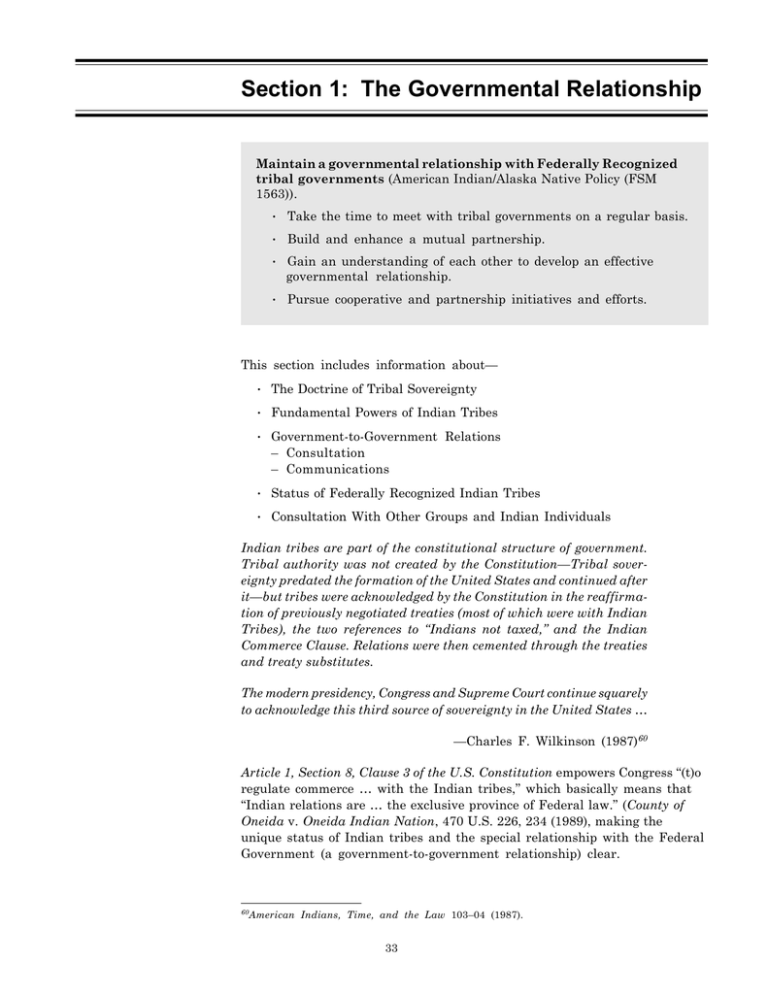
Section 1: The Governmental Relationship
Maintain a governmental relationship with Federally Recognized
tribal governments (American Indian/Alaska Native Policy (FSM
1563)).
•
Take the time to meet with tribal governments on a regular basis.
•
Build and enhance a mutual partnership.
•
Gain an understanding of each other to develop an effective
governmental relationship.
•
Pursue cooperative and partnership initiatives and efforts.
This section includes information about—
•
The Doctrine of Tribal Sovereignty
•
Fundamental Powers of Indian Tribes
•
Government-to-Government Relations
– Consultation
– Communications
•
Status of Federally Recognized Indian Tribes
•
Consultation With Other Groups and Indian Individuals
Indian tribes are part of the constitutional structure of government.
Tribal authority was not created by the Constitution—Tribal sovereignty predated the formation of the United States and continued after
it—but tribes were acknowledged by the Constitution in the reaffirmation of previously negotiated treaties (most of which were with Indian
Tribes), the two references to “Indians not taxed,” and the Indian
Commerce Clause. Relations were then cemented through the treaties
and treaty substitutes.
The modern presidency, Congress and Supreme Court continue squarely
to acknowledge this third source of sovereignty in the United States …
—Charles F. Wilkinson (1987)60
Article 1, Section 8, Clause 3 of the U.S. Constitution empowers Congress “(t)o
regulate commerce … with the Indian tribes,” which basically means that
“Indian relations are … the exclusive province of Federal law.” (County of
Oneida v. Oneida Indian Nation, 470 U.S. 226, 234 (1989), making the
unique status of Indian tribes and the special relationship with the Federal
Government (a government-to-government relationship) clear.
60American
Indians, Time, and the Law 103–04 (1987).
33
Worcester v. Georgia 31 U.S. (6 Pet) 515 (1832) reinforced three bedrock
principles relating to Indian tribes:
•
Indian tribes, because of their aboriginal and territorial status, possessed certain incidents of preexisting sovereignty.
•
The United States could reduce or eliminate such sovereignty, but
individual States could not.
•
The tribes’ limited inherent (preexisting) sovereignty (Fletcher, 10 U.S.
(6 Cranch) at 147) and their corresponding dependency on the United
States for protection imposed a trust responsibility on the United
States.
These principles shape American Indian law:
The Doctrine of
Tribal Sovereignty
•
Sovereignty
•
The Federal-to-Tribe (government-to-government) relationship
•
The “Trust Responsibility” of the U.S. Government to Indian tribes
Indian tribes are not foreign nations, but distinct political entities,
governing themselves, and making treaties with the United States (Cherokee
Nation v. Georgia (1831)). Their relationship to the United States Government is
that of domestic, dependent nations—the relationship is similar to that between
wards and their guardians.
Indian Nations had always been considered distinct, independent
political communities, retaining their original natural rights, as the
undisputed possessors of the soil … The very term “nation” so generally applied to them means “people distinct from others.”
—John Marshall, 1832
Worcester v. Georgia
31US(6 Pet.)515, 561
Indian tribes recognized by the U.S. Government have a special and unique
legal and political relationship with the Government, defined by history,
treaties, statutes, court decisions, and the U.S. Constitution. Although the
U.S. Constitution does not apply to tribes, Article 1, Section 8, Clause 3
authorizes Congress to regulate “… commerce … with Indian tribes.”
The important point of sovereignty is that tribes are independent nations.
Some characteristics of sovereignty are:
•
Tribes were not granted sovereignty, they have always possessed it.
•
Indian tribal governments have always maintained sole responsibility
to perpetuate their status as sovereign nations and to exercise their
rights as defined by treaty or other statute.
•
Depending upon the legal document establishing a tribe’s status and
recognition, there may be certain rights that only Congress can alter.
•
Sovereignty is a status rigorously guarded and maintained by tribal
governing bodies, Indian Nations to not delegate sovereignty to other
entities.
34
The Supreme Court has found—
Fundamental
Powers of Indian
Tribes
•
That tribal governments are “unique aggregations possessing attributes
of sovereignty over both their members and their territory.”61
•
That tribal powers not limited by Federal statute, by treaty, by restraints implicit in the protectorate relationship, or by inconsistency
with their status remain with tribal governments or reservation communities.62
Attributes of Sovereignty. Most tribal governments possess and exercise
inherent self-government powers unless such powers have been extinguished. Tribal governments frequently have considerable powers that are
separate and equal to those of State and local governments, particularly
civil and criminal jurisdiction over individuals and corporations. The
following are fundamental categories of tribal government power that have
been recognized under Federal law. These are also the attributes of sovereignty:
Attributes of Sovereignty
• The power to establish a form of government.
• The power to determine membership.
• The power to legislate or otherwise adopt substantive civil and
criminal laws.
• The power to administer justice.
• The power to exclude persons from the territory or reservation.
• The power to charter business organizations.
• The power of sovereign immunity.
Powers of Alaska Native Tribes and Groups. Absence of treaties between
the United States and Alaska Natives precluded the development of the
“dependent sovereignty” status. The inherent governmental powers that
treaty making addressed with the Indian Nations in the “lower 48” are not
found in the developing relations with Alaska Natives and their respective
tribal governments, societies, or clans. This lack of recognition has
contributed to Alaska Natives’ continued difficulties in exercising tribal
powers with both the State and Federal governments and undermined
rather than supported Alaska Native tribal powers.
When the Indian Reorganization Act of 1934 was originally passed, it did not
fully take into account the unique needs of Alaska Natives. In 1936, it was
amended to do so. Thus, the Federal Government acknowledged a relatively
limited and fragmented landownership-related trust responsibility toward
Alaska Natives. One benefit resulting from the act took place in the following year, 1937, when Congress made reindeer herding an exclusively Native
61
62
United States v. Wheeler, 435 U.S. 313 (1978).
F. Cohen. Handbook of Federal Indian Law 232–35 (1982).
35
activity. Through such activities, Congress was treating Alaska Natives in
much the same way as they did Indian tribes elsewhere.
Eventually, executive orders created more than 150 special Native reserves
to support reindeer herding, schools, and vocational education. Some
reserves were also created to protect extensive areas for subsistence
activities. Only one Indian reservation was ever established in Alaska at
Metlakatla. It was created under unique circumstances by an Act of
Congress in 1891 (Price 1990:78–83). At that time, Alaska was still a
territory. Creation of these reserves provoked fierce battles between territorial leaders and the Secretary of the Interior over who would control Alaska
lands and resources. The territorial leaders viewed the reserves as barriers to Alaska’s development and the progress of its people—a view reinforced by the Federal Government’s termination policy in the early 1950’s.
Government-toGovernment
Relations:
Consultation
National Forest System lands are public lands. While most Indian title
to these lands has been extinguished, the Forest Service has to be
concerned where there are—
•
Tribal rights reserved by treaty.
•
Spiritual and cultural values and practices and archeological
and heritage resources.
•
Adjacent tribal or trust lands.
•
Tribal water rights.
Tribes are sovereign nations and other governments. They are not publics.
Consultation with tribes will be discussed throughout this document.
Consultation with tribal governments must be established and maintained
for a lasting government-to-government relationship.
Whom to Consult
Government-to-government consultation may only take place between
the Federal Government and Federally Recognized Indian Tribes.
Many tribes have at least two forms of leadership—the elected body
and the traditional/spiritual leaders. Consultation with tribal governments occurs through the elected tribal officials—presidents or chairpersons of tribal executive or business councils, headmen or women, and
governors in some Southwest tribes. Federal heritage laws may
include consultation with traditional cultural or spiritual leaders as
well as elected tribal government leaders.
•
The Forest Service contact for government-to-government consultation
is the line officer at the Forest Service level where a decision that
may affect a tribe will be made.
•
The line officer initiates and develops the government-to-government
consultation.
•
The Forest Service line officer in this government-to-government
consultation is acting as a representative of the President of the
United States.
36
Conducting
Consultation
Consider the following in conducting government-to-government
consultation with Indian tribes:
•
Conduct consultation with official tribal leadership.
•
Visit, listen, and communicate in person.
•
Respect tribes as sovereign governments.
•
Seek an understanding of how the tribe wishes to be consulted.
•
Identify preferred methods of communication, develop protocols or
a Memorandum of Agreement on how consultation should be
conducted.
•
Develop points of contact for tasks (such as staff work). Determine
with whom staff work should be conducted.
•
Be sensitive to the effects of history on the consultation relationship. There may be a lack of trust.
•
If consultation is likely to occur repeatedly, or with a number of
different tribes, with the tribe’s agreement, consider establishing a
consultation working group.
•
Be flexible—especially with deadlines. If particular deadlines must
be set, be sure to explain them and why they exist. Expect to
negotiate.
•
Conduct field trips. Understanding is generally shared on field
visits.
•
Questions may not be answered immediately. It may be necessary
to pose a question and allow tribal leaders to think about the
question and discuss it with tribal committees, members, or tribal
councils.
•
Be clear about whether you are notifying the tribe of an action or
consulting with them and seeking agreement. For actions on
National Forest System lands, some statutes such as the Archaeological Resources Protection Act (ARPA) require notification, but
not necessarily consent, although consent/agreement is certainly
the desired outcome.
•
Respect confidentiality.
Specific steps of consultation can be developed with specific tribes.
This information can be formalized in an agreement or in a regional
tribal resource book.
Laws That
Several authorities may require consultation with tribes:
Require Consultation
• The National Environmental Policy Act (NEPA). Regulations implementing
NEPA at 40 CFR 1507.7, require Federal agencies to invite Indian tribes
to participate in the scoping process on projects or activities that affect
them.
37
Tribes with treaty rights upon National Forest Service lands may also
meet with line officers in advance of the formal planning processes
about their reserved rights.
•
Federal Land Policy and Management Act of 1976 (90 Stat 2743;
43 U.S.C. 1712, Sec 202 (b). This act directs the Secretary of Agriculture to coordinate National Forest System land use planning with
Indian tribal land use planning (Table 1.1.) (page 39).
•
The National Forest Management Act (NFMA) and Forest and Rangeland
Renewable Resources Act (RPA) for forest planning.
•
Historic Preservation laws.
•
Executive orders such as the one on Indian Sacred Sites. (See
Appendix A.)
See also Table 1.1 (page 39).
Communication
It is important to distinguish between government-to-government
consultation and the communications, coordination, and public
involvement efforts commonly carried out between tribal government staff
members and equivalent Forest Service staff and employees. Many tribes
have technical staff, legal counsel, advisors, and administrators employed
to help run tribal affairs. These staff people usually do not speak on behalf
of the tribe about tribal policies or other tribal governmental actions.
However, they can be invaluable professional contacts for Forest Service
staffs. Staff-to-staff work can continue or even precede government-togovernment consultations.
Intertribal Groups and Organizations. There may be groups, such as the
Intertribal Timber Council, the Native American Fish and Wildlife Society,
and others that provide information, advice, and technical assistance to the
tribes on resource matters, but these groups do not speak for or represent
the tribes. Contact with such groups does not substitute for the Forest
Service conducting government-to-government consultation with elected
tribal officials.
Status of Federally
Recognized Indian
Tribes
The Forest Service conducts government-to-government consultation only
with Federally Recognized Tribes.
Federally Recognized Indian Tribes. Federal recognition is the
acknowledgment of an Indian tribe by the Secretary of the Interior as a
tribal government with a special relationship with the U.S. Government.
This unique and special relationship recognizes that Indian tribes receive
some benefits and reserve some rights not available to other citizens. The
process, regulations, and criteria for attaining Federal recognition are
found in 25 CFR 83.
Treaty Indian Tribes. Until 1871, Congress developed, negotiated, and
ratified formal treaties with individual tribes or confederated tribes. Early
cases clarifying these treaties established the basic elements of Federal
Indian law. Treaty Indian tribes are governments that have retained rights on
Federal or other lands that may include hunting; fishing; gathering food and
38
Table 1.1.—Tribal Coordination and Consultation Requirements
Law
Whom
To Contact
Subject
Time Frame
AIRFA—American Indian
Religious Freedom Act
Traditional Religious
Practitioners
Obtain and consider views
during decisionmaking.
Not specific.
ARPA—Archaeological
Resources Protection Act
Tribal Officials
If permitted work may harm or
impact an “Indian religious or
cultural site on public lands.”
FS must notify the
tribe 30 days before
issuing a permit.
NFMA—National Forest
Management Act
Tribal Officials
Provide opportunity to raise issues
and comment on land-use plans,
and ensure consistency between
FS and the tribe’s land use plans.
Vary depending
upon the stage of
the planning
process. 30 days or
more.
NAGPRA—Native
American Graves
Protection and
Repatriation Act
Tribal Officials, Lineal
Descendants, and
Culturally Affiliated
Groups
Treatment and disposition of human
remains and associated funerary
items and items of cultural
patrimony. Also, when human
remains or associated funerary
items are accidently discovered.
Not specific, but
because of ref. to
ARPA, 30 days
before excavation.
FS must notify
the tribe within
3 working days and
mitigation must be
completed within
30 days of
discovery.
NEPA—National
Environmental Policy
Act
Tribal Officials
Provide opportunity to participate
in land management decisionmaking.
Scoping process,
comment period,
30 days on EA;
45 days on EIS.
NHPA—National Historic
Preservation Act
Tribal Officials,
Traditional Cultural
Leaders
Provide opportunity to consult
as “interested persons” if action
may affect properties of historic
value to an Indian tribe on nonIndian lands.
Not specific, but
incorporate in
NEPA.
Invite to participate as concurring
parties when they request it.
Not specific.
RFRA—Religious
Freedom Restoration
Act
Religious Practitioners
Ensure agency decisions do not
burden free exercise of religion
(access, use, or ritual practice)
Not specific.
EO Government-toGovernment Relations
Tribal Governments
Consult to greatest extent and
operate within a government-togovernment relationship.
Not specific.
EO Sacred Sites
Tribal Officials and
Religious Leaders
Accommodate access to and
ceremonial use of sacred sites and
avoid physically affecting the
integrity of such sites.
Not specific but
incorporate into
NEPA/NFMA.
39
cultural and medicinal plants; and grazing livestock on open and unclaimed lands.
Executive Order Tribes. Not all reservations were established by treaty. Some
reservations were identified or created by executive order. Between 1871,
when Congress discontinued formal treaty making, and 1910, tribes not
previously recognized were surfaced by executive order.
As a rule, executive order tribes rarely reserved off-reservation rights or
privileges. Therefore, the Forest Service may have different land management
responsibilities for areas adjacent to or neighboring executive order tribes than
they do with treaty tribes. The Forest Service must consult with both.
Alaska Native Corporations (Alaska Native Claims Settlement Act of 1971—
ANCSA Corporations). Congress passed ANCSA in an attempt to accomplish
a fair and just settlement of all aboriginal land claims by Alaska Natives
and Alaska Native groups. Native corporations under ANCSA do not take
the place of tribal governments in Alaska, where there are 226 Federally
Recognized Tribes. These tribes have traditional governments formed under
the Indian Reorganization Act of 1934 (amended in 1936 to include Alaska
Natives) and have a unique relationship with the Federal Government. The
Forest Service works on a government-to-government basis with these
Federally Recognized Tribes—not the Native Corporations.
Non-Federally-Recognized Indian Groups. There are a number of Indian
communities and groups who identify themselves as tribes, but are not
Federally acknowledged. The Forest Service has neither the authority nor the
obligation to work with these groups on a government-to-government basis,
although the Forest Service may work with them as other interested
publics.
Consultation
With Other Groups
and Individuals
Although the Forest Service may work with American Indian or Alaska
Native individuals, groups, organizations, and communities in compliance
with NEPA, NFMA, and other related laws, this is not recognized as
government-to-government consultation.
However, types of consultation other than government-to-government
consultation, with traditional practitioners, communities, and other interested parties may be conducted to comply with NEPA, NFMA, the American
Indian Religious Freedom Act (AIRFA), and the Native American Graves
Protection and Repatriation Act (NAGPRA) (the latter for lineal descendants).
•
The National Historic Preservation Act (NHPA) requires consultation with
traditional practitioners and communities and other interested parties.
•
AIRFA encourages Federal agencies to consider traditional practices,
which often have spiritual associations and connotations, and recommends that the Forest Service also contact nonrecognized groups about
cultural sites and archeological sites and resources.
There may be non-Indian groups or organizations claiming to represent
tribal views and positions. In these instances, Forest Service staff should
consult with Indian tribes and groups to verify this representation.
40


